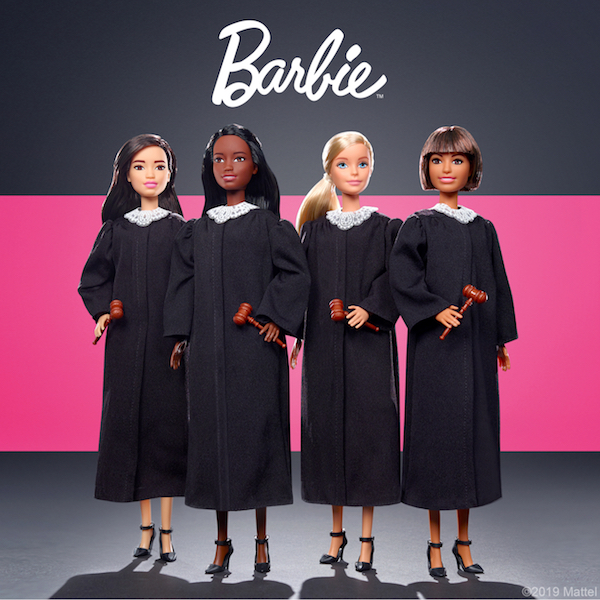Meet Lawsuit Barbie: She's been busy at Barbie's courthouse

Fans have flocked to theaters to catch the new Barbie live-action film since it opened Friday. The blockbuster is the story of Barbie and fellow Barbies who reside in Barbieland. Barbie suffers an existential crisis and travels to the real world to learn the truth about the universe. Photo courtesy of Mattel Inc.
Tom Forsythe, a Utah photographer, created dozens of images depicting nude Barbie dolls posed with kitchen appliances. His “Food Chain Barbie” series included “Malted Barbie,” showing Barbie placed on a vintage Hamilton Beach malt machine. Another, which Forsythe titled “Barbie Enchiladas,” showed four Barbies in a lit oven wrapped in tortillas and covered with salsa in a casserole dish.
Mattel Inc., owner of various rights to the iconic doll, sued for infringement. But Forsythe prevailed. The 9th U.S. Circuit Court of Appeals, in Mattel Inc. v. Walking Mountain Productions (2003), concluded that the photographer’s work, being social criticism and parody, was “fair use” of Mattel’s copyright and protected by the First Amendment.
“In some of Forsythe’s photos, Barbie is about to be destroyed or harmed by domestic life in the form of kitchen appliances, yet continues displaying her well-known smile, disturbingly oblivious to her predicament,” the court observed. “It is not difficult to see the commentary that Forsythe intended or the harm that he perceived in Barbie’s influence on gender roles and the position of women in society.”
Fans have flocked to theaters to catch the new Barbie live-action film since it opened Friday. The blockbuster is the story of Barbie and fellow Barbies who reside in Barbieland. Barbie suffers an existential crisis and travels to the real world to learn the truth about the universe.
Spoiler alert: Barbie has been living in the real world for a long time. Because of the doll’s colossal success since its introduction in 1959, countless lawsuits like this one have gone through the courts as the doll’s maker has sought to enforce its rights and protect her image. When Mattel sees Barbie under attack, it is not beyond its ken to know what to do about it.
To celebrate the millennium, the operator of Radio City Music Hall created a doll named “Rockettes 2000.” Mattel came out kicking. It filed suit, alleging that the Rockette doll copied facial features from two different Barbie dolls.
The U.S. District Court for the Southern District of New York concluded that copyright protection did not extend to Barbie’s eyes, nose and mouth. But the 2nd U.S. Circuit Court of Appeals disagreed. While not reaching the specific question of whether the Rockette doll was copied from Barbie, the court in Mattel Inc. v. Goldberger Doll Manufacturing Co. (2004) noted: “We can surmise that in the highly competitive, billion-dollar doll industry, getting the doll’s face and expression exactly right is crucial to success.”
Not surprisingly, Mattel filed suit to put a stop to a website selling adult entertainment services under the name “Barbie’s Playhouse.” Following a trial, then-District Judge Sonia Sotomayor, of the Southern District of New York, concluded in Mattel Inc. v. Jcom Inc. (1998) that the website—based on the shade of pink used and font to write the word “Barbie”—intended to copy and trade upon Mattel’s goodwill in its trademark.
Not long after, Mattel was back in the Southern District of New York, challenging an adult entertainment website’s use of the domain name “barbiesplaypen.com.” The court, in Mattel Inc. v. Internet Dimensions Inc. (2000), ordered that the domain name be transferred to Mattel: “The Barbie dolls, with their long blonde hair and anatomically improbable dimensions, are ostensibly intended to portray wholesomeness to young girls.” But the “models” on the “barbiesplaypen.com” site, the judge concluded, were, um, engaging in anything but “wholesome activities.”
Toy company Kenner and the Miss America Organization created a “Miss America” line of five dolls. Here she comes.
Mattel believed that three of the dolls (Devon, Tonya and Blair) violated its Barbie copyright. Mattel had a shipment of the dolls, imported from China, detained by U.S. Customs on suspicion of infringement. Since all five dolls were packed together, Justine and Raquel also were held.
Kenner and the Miss America Organization sued Mattel in the Southern District of New York, seeking a declaration that the dolls did not infringe Mattel’s copyright as well as an injunction barring Mattel from interfering with their importation of the dolls.
The court concluded that judicial intervention was premature and the matter should be handled by Customs using the administrative process set out in Treasury Department regulations. The 2nd U.S. Circuit Court of Appeals, in Miss America Organization v. Mattel Inc. (1991), affirmed. No word on whether Justine and Raquel were granted habeas corpus relief.
Susanne Pitt created and sold a “Dungeon Doll,” which appeared to be a Barbie doll repainted and recostumed in a lederhosen-style Bavarian bondage dress and helmet with a mask and waspie. Barbie, for the umpteenth time, found herself in lower Manhattan. Mattel sought an injunction in the Southern District of New York restraining Pitt from infringing its copyrighted works.
In denying Mattel’s motion for summary judgment, the court in Mattel, Inc. v. Pitt (2002) concluded that Pitt may have been entitled to a “fair use” defense because her dolls were, “to put it mildly,” “transformative” and not merely “supplanting” the original Barbie doll.
“A different analysis would apply,” the court declared, “if [Pitt] had, for example, dressed Barbie dolls in a different style of cheerleader outfit than those marketed by Mattel. To the court’s knowledge, there is no Mattel line of ‘S&M’ Barbie.”
In addition to her numerous other skills, the storied doll has kept members of the bar busy.

Randy Maniloff is an attorney at White and Williams in Philadelphia and an adjunct professor at the Temple University Beasley School of Law. He runs the website CoverageOpinions.info.
This column reflects the opinions of the author and not necessarily the views of the ABA Journal—or the American Bar Association.



